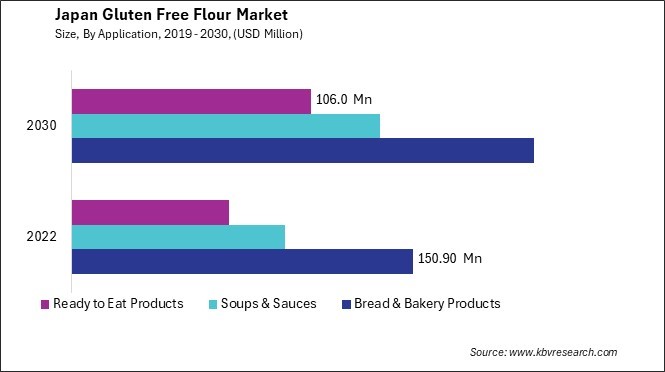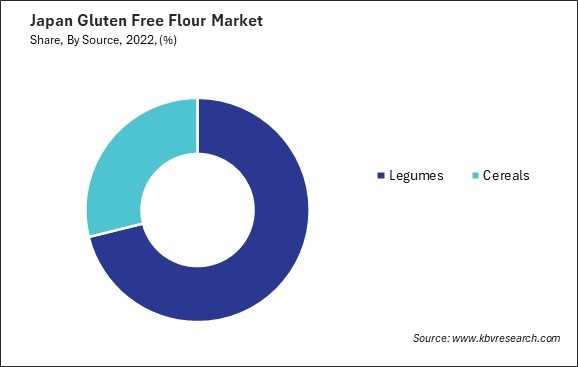The Japan Gluten Free Flour Market size is expected to reach $446.9 Million by 2030, rising at a market growth of 4.5% CAGR during the forecast period. In the year 2022, the market attained a volume of 40.2 Kilo Tonnes, experiencing a growth of 4.9 % (2019-2022).
One of the key drivers of the expanding food industry in Japan is the growing demand for convenience and ready-to-eat meals. As lifestyles become more fast-paced, consumers increasingly seek convenient food options requiring minimal preparation. As a consequence, convenience stores, as well as food service establishments, have increased, providing a diverse selection of ready-to-eat snacks, meals, and beverages in order to accommodate consumers' demands.

Additionally, globalization has substantially impacted the development of the Japanese food industry. The country has been influenced by international food trends and cuisines, leading to the adoption of new flavors, ingredients, and cooking techniques. This has contributed to the diversification of the food industry, with a wide variety of international foods and fusion cuisines now available to consumers.
Technological advancements have also impacted Japan's food industry, particularly in terms of food production, distribution, and marketing. Innovations in food processing and packaging have enabled the development of new products and improved the shelf life of perishable items. Additionally, e-commerce and digital marketing have transformed the way food products are marketed and sold, allowing for greater accessibility and convenience for consumers.
Thus, the increasing demand for gluten-free flour in Japan is driven by a combination of factors, including health considerations, changing consumer preferences, global influences, and a growing awareness of gluten-related issues. As this trend continues, the market for gluten free flour in Japan will continue to expand, offering new opportunities for producers and suppliers in the food industry.
Amaranth flour is advantageous to a broad spectrum of consumers due to its nutritional value, nutty flavor, and gluten-free status; it is derived from the seeds of the amaranth plant. One of the key drivers of the rising demand for amaranth flour in Japan is the increasing popularity of gluten-free diets. As awareness of celiac disease, gluten sensitivities, and the health benefits of gluten-free diets grows, more consumers are seeking out gluten-free alternatives to traditional wheat flour. Due to its gluten-free characteristics, amaranth flour has gained significant popularity among individuals seeking to maintain a gluten-free diet while indulging in a diverse range of baked goods.
Furthermore, the increasing prevalence of amaranth flour in Japan can be attributed to its favorable nutritional composition. Protein, vitamins, dietary fiber, and minerals are abundant in amaranth, which makes it a nutritious option for those seeking to increase their consumption of whole grains. The nutritional benefits of amaranth flour align with the broader trend towards healthier eating habits, where consumers are seeking out foods that offer both nutritional value and culinary versatility.
Furthermore, the success of amaranth flour in the Japanese market has encouraged the development of new gluten-free products and recipes that utilize gluten-free flour. Food manufacturers and chefs are incorporating gluten-free flours, including amaranth flour, into a variety of products and dishes, expanding the range of gluten-free options available to consumers. This innovation and creativity in gluten-free cooking and baking have contributed to the overall growth and dynamism of the gluten free flour market in Japan.
The increasing use of gluten-free flour in soups and sauces in Japan is a reflection of evolving consumer preferences, dietary trends, and a growing awareness of the benefits of gluten-free options. In Japan, soups and sauces are integral components of the culinary tradition, with a long history of being used in various traditional and contemporary dishes. One of the key factors driving the high consumption of soups and sauces in Japan is the emphasis on umami, the fifth basic taste often described as savory and rich. Soups and sauces enhance the umami flavor in many Japanese dishes, adding depth and complexity to the overall flavor profile. This focus on umami is deeply rooted in Japanese culinary traditions and is a defining characteristic of Japanese cuisine.
The versatility of soups and sauces also contributes to their high consumption in Japan. Soups and sauces possess the capacity to be modified for an extensive array of dishes, spanning from uncomplicated midweek fare to sophisticated plated presentations. This adaptability permits innovation and creativity in Japanese cuisine, as chefs and home cooks are able to experiment with various flavors and ingredients to produce distinctive and varied dishes.
One significant reason for the increasing use of gluten-free flour in soups and sauces is the desire to accommodate individuals who follow gluten-free diets due to celiac disease, gluten sensitivities, or other health reasons. As awareness of these conditions grows among consumers and food service providers, there is a greater emphasis on offering gluten-free options across a wide range of food categories, including soups and sauces. This has led to the development of recipes and culinary techniques that utilize gluten-free flour as a substitute for traditional wheat-based thickeners or binding agents in soups and sauces.

In Japan, the market for gluten free flour has been witnessing growth, driven by factors such as increasing awareness of gluten-related issues, changing dietary preferences, and a growing demand for gluten-free alternatives. The gluten free flour market in Japan is being populated by a number of companies that provide numerous varieties of products to satisfy the demands of consumers who are in search of gluten-free alternatives.
One prominent Japanese gluten free flour market player is Nisshin Seifun Group Inc., a leading flour milling company expanding its portfolio to include gluten-free flour products. Investing in research and development to produce gluten-free flour blends that mimic the flavor and texture of conventional wheat flour, Nisshin Seifun caters to consumers seeking gluten-free baking and cooking alternatives.
Kewpie Corporation is another significant player in the Japanese market, known for its diverse range of food products. Kewpie has been actively developing gluten-free flour products to meet the demand for gluten-free options, particularly in the context of Japanese cuisine, where flour is used in various traditional dishes and culinary applications.
Additionally, there are smaller-scale producers and suppliers in Japan's gluten free flour market that cater to niche segments or specialize in specific types of gluten-free flour. These companies often focus on providing high-quality, specialty gluten-free flours made from alternative grains such as rice, corn, or buckwheat, commonly used in Japanese cooking and baking.
Imported brands of gluten-free flour also play a role in the Japanese market, offering consumers a wider variety of options. These brands often bring unique formulations and blends from other countries, catering to the diverse needs of the gluten-free consumer base in Japan.
Overall, the gluten free flour market in Japan is characterized by a mix of established flour milling companies, food manufacturers diversifying their product lines, niche producers focusing on specialty flours, and imported brands offering a variety of options to consumers seeking gluten-free alternatives. With the expansion of consumer awareness and the growing demand for gluten-free products, the market will likely witness additional developments and rivalries as companies strive to secure a portion of this expanding sector.
By Application
By Source
By Product
Our team of dedicated experts can provide you with attractive expansion opportunities for your business.

